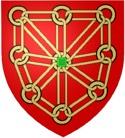Family Card - Person Sheet
Family Card - Person Sheet
Misc. Notes
Sancho III Garcés (c. 985 – October 18, 1035), called the Great (Spanish: el Mayor or el Grande), was Count of Aragón and King of Navarre from 1000 or 1004 until his death and Count of Castile from 1029 to his death. During his lifetime, he was the most important Christian monarch of Spain. Having gone further than any of his predecessors in uniting the divided kingdoms of Spain, his life's work was undone when he divided his domains shortly before his death to provide for each of his sons.
Sancho was married to Muña Mayor Sánchez, daughter of count Sancho I of Castile. Besides four legitimate sons he also fathered one, by his mistress Sancha de Aybar, named Ramiro, who was the eldest of his sons but, as a bastard, not entitled to succeed. Before his death in 1035, Sancho divided his possessions among his sons. García received Navarre and the Basque country with a certain seniority over his brothers (a "high kingship"), Ferdinand received Castile as a kingdom, and Gonzalo got Sobrarbe and Ribagorza, also raised to kingdom status. The illegitimate son obtained the county of Aragón, which was elevated to a kingdom, small as it was at the time (Ramiro was known as "the petty king").
Legacy
He introduced French feudal theories and ecclesiastic and intellectual currents into Spain. The division of his realm upon his death, the concepts of vassalage and suzerainty, and the use of the phrase "by the grace of God" after his title were imported from France, with which he tried to maintain relations. For this he has been called the "first Europeaniser of Spain." His most obvious legacy, however, was the temporary union of all Christian Spain. At least nominally, he ruled over León, the ancient capital of the kingdom won from the Moors in the eighth century, and Barcelona, the greatest of the Catalan cities. Though he divided the realm at his death, thus created the enduring legacy of Castilian and Aragonese kingdoms, he left all his lands in the hands of one dynasty, the Jiménez, which kept the kingdoms allied by blood until the twelfth century. He made the Navarrese pocket kingdom strong, politically stable, and independent, preserving it for the remainder of the Middle Ages. Though, by dividing the realm, he isolated the kingdom and inhibited its ability to gain land at the expense of the Moslems. It is for this that his seal has been appropriated by Basque nationalism. Summed up, his reign defined the political geography of Spain until the union of the peninsula under the Catholic Monarchs.
Sancho was married to Muña Mayor Sánchez, daughter of count Sancho I of Castile. Besides four legitimate sons he also fathered one, by his mistress Sancha de Aybar, named Ramiro, who was the eldest of his sons but, as a bastard, not entitled to succeed. Before his death in 1035, Sancho divided his possessions among his sons. García received Navarre and the Basque country with a certain seniority over his brothers (a "high kingship"), Ferdinand received Castile as a kingdom, and Gonzalo got Sobrarbe and Ribagorza, also raised to kingdom status. The illegitimate son obtained the county of Aragón, which was elevated to a kingdom, small as it was at the time (Ramiro was known as "the petty king").
Legacy
He introduced French feudal theories and ecclesiastic and intellectual currents into Spain. The division of his realm upon his death, the concepts of vassalage and suzerainty, and the use of the phrase "by the grace of God" after his title were imported from France, with which he tried to maintain relations. For this he has been called the "first Europeaniser of Spain." His most obvious legacy, however, was the temporary union of all Christian Spain. At least nominally, he ruled over León, the ancient capital of the kingdom won from the Moors in the eighth century, and Barcelona, the greatest of the Catalan cities. Though he divided the realm at his death, thus created the enduring legacy of Castilian and Aragonese kingdoms, he left all his lands in the hands of one dynasty, the Jiménez, which kept the kingdoms allied by blood until the twelfth century. He made the Navarrese pocket kingdom strong, politically stable, and independent, preserving it for the remainder of the Middle Ages. Though, by dividing the realm, he isolated the kingdom and inhibited its ability to gain land at the expense of the Moslems. It is for this that his seal has been appropriated by Basque nationalism. Summed up, his reign defined the political geography of Spain until the union of the peninsula under the Catholic Monarchs.



